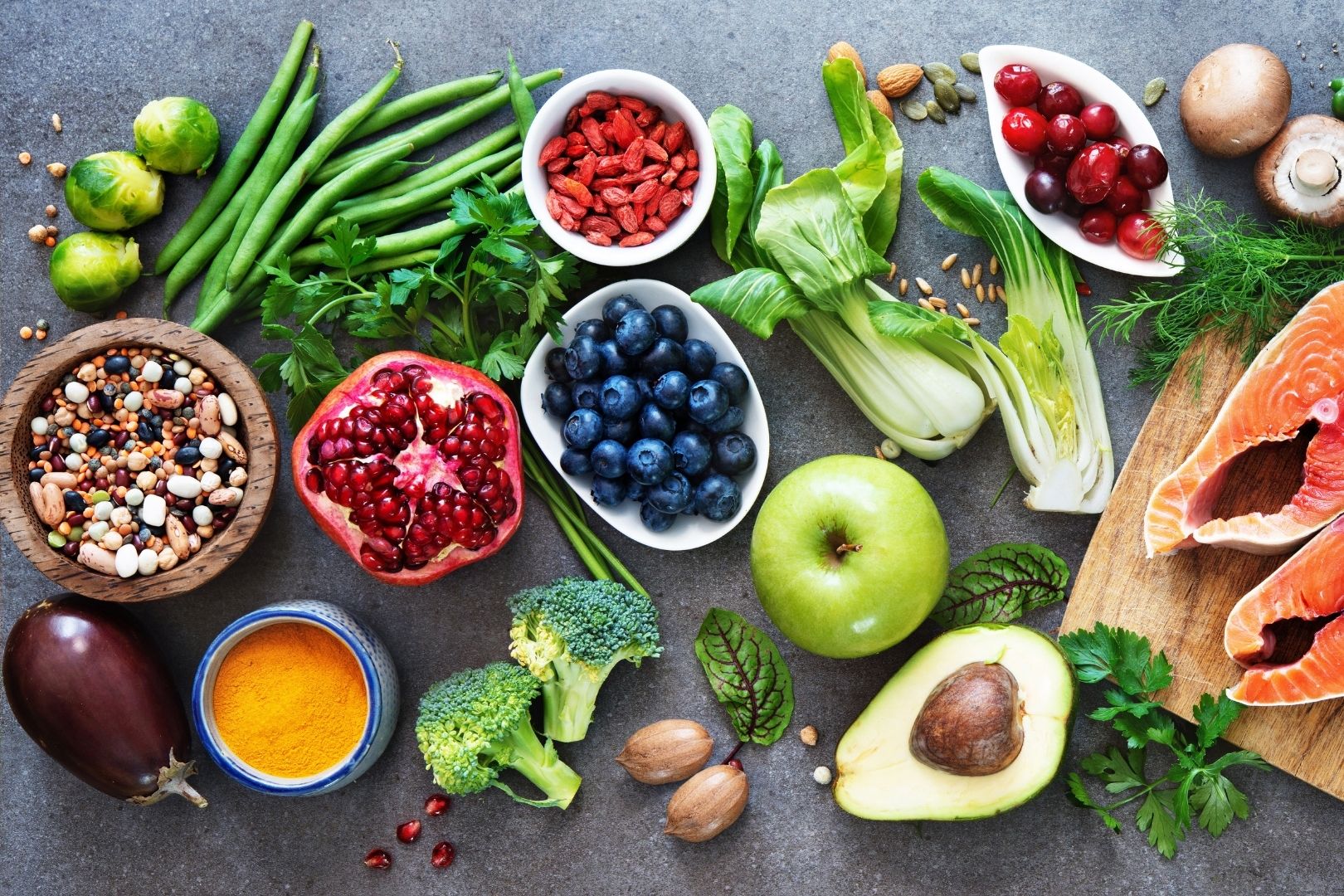Have you seen your doctor for a routine check-up and were told that your blood sugar is on the rise? For many of my clients, the first time they learned that something was different about their health was by getting routine lab results back… and being surprised by what the values were.
Are you looking for answers on the best diet for insulin resistance that can help you to improve those lab values, and feel more confident and energetic, without feeling lost in a Google search alone?
Taking control of your insulin resistance lowers your risk of developing prediabetes and type 2 diabetes. So many people feel confused and alone trying to figure things out by themselves, without an expert guide.
In this blog post, we will discuss what diet is best for those with insulin resistance as well as provide a downloadable PDF guide with practical ways to make progress starting today.
>> Download PDF Guide <<
As a registered dietitian, I help my clients to cultivate personalized plans to take charge of their health with a course of action that feels doable and a meal plan that tastes great and includes your favorite foods. I promise it isn’t too good to be true!
Let’s start by uncovering what prediabetes and insulin resistance are, and how you can take action to manage them with confidence.

What is insulin?
Insulin is a hormone that your body makes in your pancreas.
Insulin plays an important role: it allows your body to be able to get the energy it needs for each and every cell. Insulin’s job is to allow glucose (sugar) to enter your cells.
In people with insulin resistance, this process does not work as well as it should, which can be attributed to many different things: we’ll cover those risk factors in a bit.
When we eat any food with carbohydrates in it — from an apple to french fries or a cookie — the carbohydrates are broken down by normal digestion into individual sugars. These sugars are small enough to enter each of your body’s cells if insulin is there to open the door.
Sometimes though, your body is not listening to insulin as well. So even though your body is still making insulin, the messages are getting ignored. Because the sugar is not going into the individual cells as efficiently, eventually this can cause a rise in blood sugar. This is insulin resistance.
What is insulin resistance?
Insulin resistance is a condition in which your body’s cells are not as sensitive to insulin. Your body is still making insulin, but your body’s cells aren’t listening to the messages quite as well. Kind of like knocking on the door to your teenager’s bedroom and they have their earbuds in. They can’t (or won’t) hear you.
Because the process isn’t going as efficiently as it should, two things can happen.
- Your body has to make more insulin to keep blood sugars normal (which means your body is working harder than it should be.)
- Your body can’t keep up and so your blood sugar levels rise.
Even if your blood sugar levels are normal, having insulin resistance means that your body is having to work harder to maintain your blood sugar levels.
In a moment, we’ll cover the labs that are important to check, beyond just your blood sugar level.
What symptoms can you have with insulin resistance?
While the best way to confirm a diagnosis is by lab markers, there are a few signs and symptoms that you might have insulin resistance. These include:
- Having difficulty losing weight
- Have PCOS
- Having fatty liver
- Having skin tags or Acanthosis nigricans (dark patches of skin, usually on the neck)
If you’re wondering about your own symptoms, I recommend reaching out to your doctor to schedule lab testing.
How common is insulin resistance?
Insulin resistance is incredibly common: according to the American Diabetes Association, it affects anywhere from one-third to one-half of all adults in the United States (1).
Lifestyle changes can help anyone with insulin resistance potentially reverse it and lower their risk of complications.
How common is prediabetes?
Prediabetes is also very common. In the US, the Centers for Disease Control and Prevention (CDC) estimates that 88 million adults, which is more than 1 in 3 people, have prediabetes (2).
What labs matter?
There is a lot that your doctor can measure in your blood, and labs are part of our overall wellness check of how your body is feeling and functioning and how much effort it takes to feel that way.
There are a couple of different lab values that I recommend you and your doctor check. These are all measurements taken from a blood sample.
Note: there are differences between blood levels for diagnosis and the treatment goals that you may establish with your healthcare team. These levels listed here are in reference to getting a diagnosis.
Fasting blood sugar
This measure of your blood sugar is taken first thing in the morning, after not eating for at least eight hours. Ideally, this number should be less than 100 mg/dL when you wake up or before a meal (3).
- Normal fasting blood sugar: < 99
- Prediabetes: 100-125
- Diabetes: 126+
Hemoglobin A1c
The next test that you may have had with your doctor is your hemoglobin A1c, which can be abbreviated HbA1c.
This lab value is a measure of your average blood sugar control, based on how much sugar is “stuck” to your red blood cells. It is a good indicator of how well your blood sugars have been managed for the past three months.
Why three months? This is how long red blood cells last in your body.
Hemoglobin is a type of red blood cell. Circulating sugars stick to red blood cells as they travel around your circulatory system, kind of like sugar sticking to a gumdrop. More sugar stuck to the red blood cells at the time of measurement means that your average blood sugar levels have been higher, too.
Keep in mind that sugar must be transported in the blood to reach every single body cell, so your hemoglobin A1c will never be zero. On the other hand, we also don’t want that number to go too high either, because excessive sugar in your blood can cause inflammation and eventually damage.
- Normal HbA1c: < 5.7%
- Prediabetes: 5.7 – 6.4%
- Diabetes: 6.5%+
Fasting insulin levels
This is another measure of your body’s response to sugar in the diet. How much insulin is circulating in your blood system in order to do the work of managing your blood sugar?
As I mentioned earlier, you can have normal blood sugars and have insulin resistance; but it does mean that your body is working harder to maintain normal blood sugar levels.
- The recommended normal range for fasting insulin varies a bit between labs, but 2 to 20 mIU/mL is considered normal by most (4).
Oral glucose tolerance test
Another test that is available to assess how well your body is processing carbohydrates is called an oral glucose tolerance test. This is a test where you arrive at the lab in the morning, having fasted and then have your baseline fasting blood sugar checked.
Then, you’re given a measured amount of a sweetened drink and your blood sugar levels are checked one hour later, and sometimes 2, 3, and 4 hours later. The goals for these blood sugar levels vary on how much sugar was in your drink and if you are pregnant or not.
Daily blood sugar tracking
Daily tracking might be something to consider with your doctor. Daily tracking provides you and your care team with more data about how your body is responding to carbohydrates and provides guidance on how much carbohydrates are the right amount for you at meals and snacks.
Daily blood sugar tracking is done at home with a small tool called a glucometer. You insert a testing strip into the glucometer, poke your finger with a lancet and place a drop of blood on the testing strip. A few seconds later, your glucometer tells you what your blood sugar levels are at that exact moment.
Typically blood sugar tracking is done in the morning (fasting) as well as 1 hour after meals.
Now that we know what insulin is, and what insulin resistance is as well as what the lab values are to track your health, you probably would like to know what may have caused the insulin resistance to begin with? Let’s dive in.
What causes insulin resistance?
As much as I wish I could offer you concrete answers to why your insulin resistance occurred, there isn’t one thing that can cause insulin resistance. Most often, it is a combination of risk factors combined.
With insulin resistance, there are risk factors that are out of your control (such as your genetics) as well as things that are more in your control (such as lifestyle); all play a role.
Things that increase the risk of insulin resistance include (5):
- Having a family history of diabetes
- Being overweight or obese
- Having polycystic ovarian syndrome (PCOS)
- History of gestational diabetes
- Being 45 years old or older
- Having sleep issues, such as sleep apnea
- Being inactive
- Your usual diet
- Certain medications, such as steroids
Having insulin resistance increases the chances you’ll develop prediabetes and eventually, type 2 diabetes.
Is there a link between prediabetes and insulin resistance?
Developing insulin resistance means that your chance of later developing prediabetes or type 2 diabetes is greater.
While that can feel scary, it is also important to know that having this knowledge of your current lab values is powerful. Insulin resistance and prediabetes don’t often have any symptoms, so even though both conditions are incredibly common, many people are not aware of their status.
With the right guidance and steps forward, you can improve your health and lower your risk of complications.
One of the most important places where you can improve your health is in your kitchen. Let’s talk about diet!
What’s the best diet for insulin resistance & prediabetes?
There isn’t one diet that is perfect for everyone with insulin resistance. And because there are so many factors at play for both conditions, there are many routes forward to gaining better control of your health as well as feeling more energized.
While you can’t change your age or genetics, you can focus on lifestyle. Remember how many different factors influence your risk of developing insulin resistance or prediabetes? There are that many different routes to managing your health. This is good news!
A personalized approach will offer you the greatest success…not to mention the greatest enjoyment.
It is really common for people to receive a new diagnosis and to try to overhaul their entire life overnight; while I can understand the motivation for quick changes, we can’t stick to changes that are so drastic.
Instead, I recommend following smaller, more incremental changes that you can feel confident about before adding new changes. Work on changes a little bit at a time, build confidence and keep going.
>> Start Managing Prediabetes Today – PDF Download <<
The best plan is one that tastes great, too.
Despite the popularity of the keto diet, I don’t recommend it: the keto diet is not sustainable and can even have harmful side effects.
And while each client’s plan is unique, there are a few common threads that most are working on. You may have heard of the Mediterranean diet before? The Mediterranean diet is well studied to boost health and lower risk of prediabetes and diabetes (6). It is a satisfying balance of protein, complex carbs, and healthy fat, with anti-inflammatory herbs and spices, lots of veggies and a glass of red wine, to boot!

In the work I do with my clients, there isn’t just one way to follow the Mediterranean diet, nor is there one best diet for insulin resistance.
My clients and I work together to create a lifestyle plan that continues to improve lab values but also honors their food preferences and lifestyle. By having the guidance of a registered dietitian, my clients see faster results with less frustration and confusion.
Here are a few tips for getting started with the best diet for insulin resistance, for you:
Increase fiber
Did you know that we are supposed to be getting 25-35 grams of fiber each and every day? Most adults are not eating nearly enough fiber; they’re not having enough whole grains, fruits, or vegetables. My clients and I work on ways to get closer to their recommended amount of fiber by incorporating more whole grains, legumes, nuts, seeds, veggies, and fruits into their meals and snacks.
Not only are these foods more filling and satisfying, but they also help with weight loss and blood sugar control. Take a look at my top 10 favorite high fiber foods here.
Increase activity
We all know that exercise is important, but many of my clients feel so pulled in a zillion directions that it just doesn’t seem feasible to actually exercise.
What can be helpful to hear is that even ten minutes of movement has measurable benefits. Especially after meals! Taking a ten-minute walk after lunch can support your body with processing carbohydrates, lowering stress, and boosting your mood (4). Exercise doesn’t have to be in a gym or last for an hour to “count.”

Learn about carbohydrates
When you first learn about insulin resistance, it can be natural to assume that you should simply avoid all carbohydrates. No carbs mean no rise in blood sugar, right?
The truth is, our body needs carbohydrates for energy; carbs are our fuel. The trick is to have the right amount of carbs at a time so that you don’t overwhelm your body’s ability to process them.
Carbs are in everything from fruits, certain vegetables, complex and whole grains, legumes (like beans and lentils), milk, and nuts as well as in foods like desserts, sweet drinks, refined grains like muffins, doughnuts, and pastries.
The bottom line is that everyone is different; working with a registered dietitian helps you to find the right nutrition plan that works for you, your lifestyle and your blood sugar.
What about medications or supplements?
Medications and supplements may be a part of your management plan; there are different options that can help support your body’s metabolism as well as how it digests and uses carbohydrates.
But, no medication or supplement will ever replace the benefits of lifestyle changes. Meds and supplements are intended to support the good work that you’re doing with nutrition, exercise, and stress management, not to replace them.
Key takeaways: Best diet for insulin resistance
The best diet – and lifestyle – for managing your insulin resistance is one that should help you to feel empowered to manage your diagnosis with confidence. It should fit into your lifestyle, not make you feel left out or defeated.
Many risk factors increase your risk of developing insulin resistance or prediabetes and so that gives you many different routes to improve your health, too. There is even the potential for your lifestyle changes to reverse your insulin resistance or prediabetes diagnosis (really!).
Working with a registered dietitian helps you to find your best plan faster and with less frustration. And when your registered dietitian is a culinary expert to boot (that’s me!), you will be confident and satisfied with your recommended meal plans and recipes. Being satisfied with your meals and snacks is so important to have a plan that feels good for the long run.
As a registered dietitian and culinary nutritionist, I can say with certainty that I am not your average prediabetes dietitian. You benefit from both my extensive nutrition training and experience but also the kitchen skills to translate those health goals into satisfying meals that you’ll truly enjoy eating...all while losing weight and lowering your blood sugar.
Ready to take charge of your health? Your first step is to book your free consultation so that we can feel certain that we’re a good fit to work together. Email me to request your free 20-minute consultation!
From there, we’ll set your big picture goals – such as reversing your prediabetes – and then break that big goal down into action-oriented steps.
Are you ready? Click here to connect by email.
